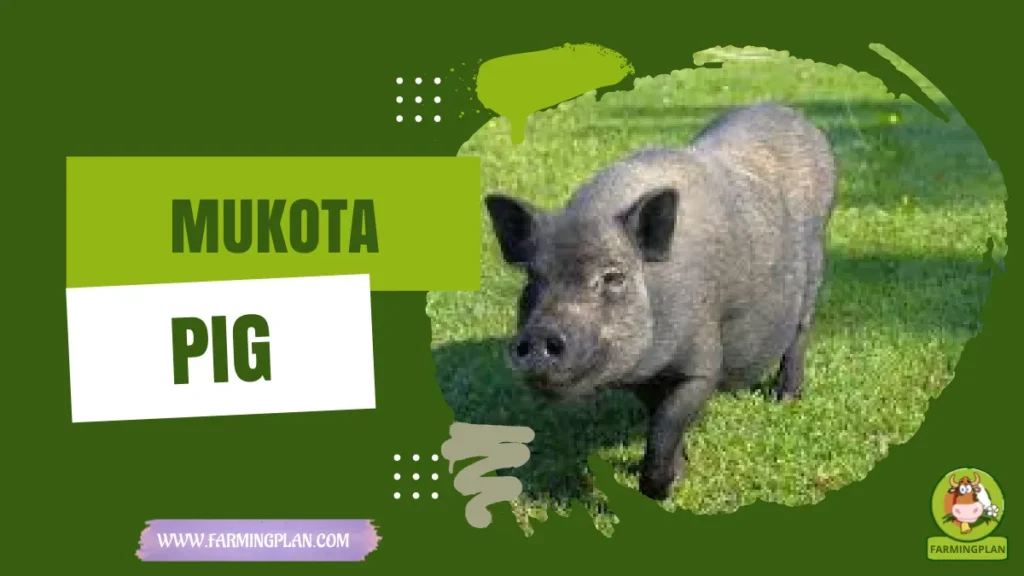Rambouillet sheep are one of the most valued breeds in the world, known for their incredible wool quality and adaptability to tough environments. Brought to fame by King Louis XVI in the 18th century, this breed has deep roots in French history and has since become a cornerstone of American sheep farming, especially across the western ranges. Farmers, breeders, and textile experts appreciate the Rambouillet for its fine wool, calm temperament, and strong frame. Whether you’re new to sheep farming or a long-time hobbyist, learning about this breed opens the door to a rich tradition of excellence in wool and livestock care.

History & Origin of Rambouillet Sheep
The story of Rambouillet sheep begins in the 18th century, when King Louis XVI of France made a bold move to improve the nation’s livestock. In 1786, he purchased over 300 Spanish Merino sheep and housed them at the Bergerie royale, located on the Rambouillet estate near Paris. This royal farm, later known as the Bergerie nationale, became the birthplace of the breed.
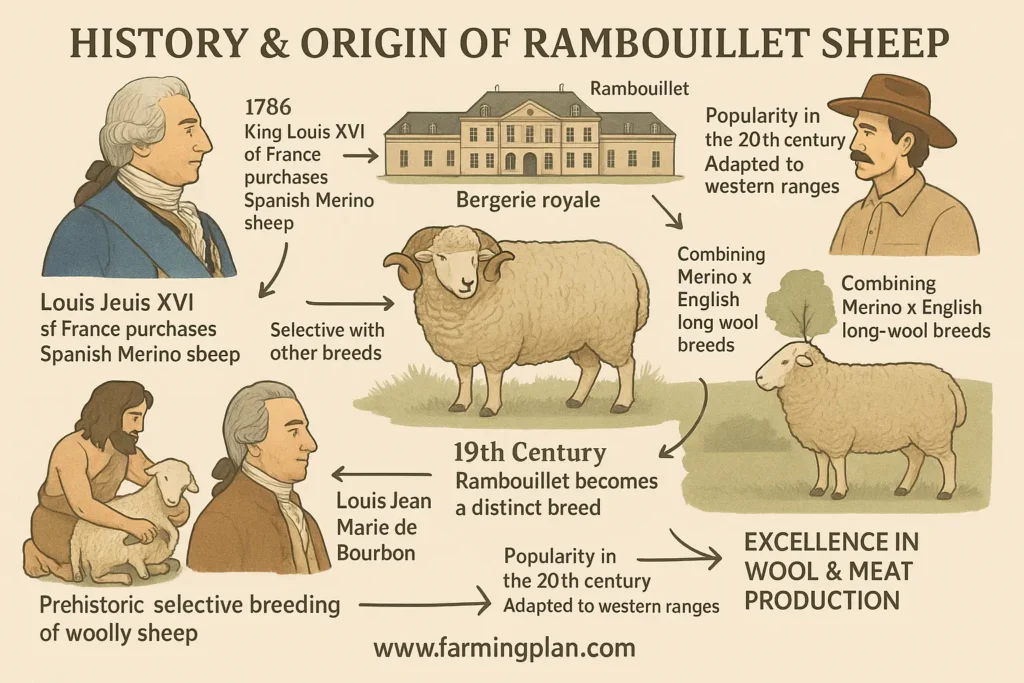
Under the direction of Louis Jean Marie de Bourbon, selective breeding programs began. Over time, these sheep were crossed with other types to improve body size, wool yield, and hardiness. By the 19th century, the Rambouillet had become a distinct breed of sheep—larger and more rugged than its Merino ancestors, but still producing the finest wool.
The breed’s popularity spread quickly. In the 20th century, American breeders saw potential in the Rambouillet for use in the western ranges. Its ability to adapt to dry climates and produce heavy fleece made it ideal for ranching operations. Rambouillets also played a major role in developing other breeds, combining the softness of Merino with the durability of English long-wool breeds.
Some experts even trace the evolution of wool production back to prehistoric times, showing how selective breeding across the 12th to 16th centuries led to innovations in wool texture and density. Today, Rambouillet sheep remain a symbol of excellence in both wool and meat production.
Characteristics of Rambouillet Sheep
Rambouillet sheep stand out with their sturdy build, soft fleece, and ability to thrive in tough conditions. This breed of sheep grows large and muscular, with rams often weighing over 300 pounds. Ewes are smaller but still strong and productive. Most rams have impressive curved horns, while ewes are typically polled (hornless).
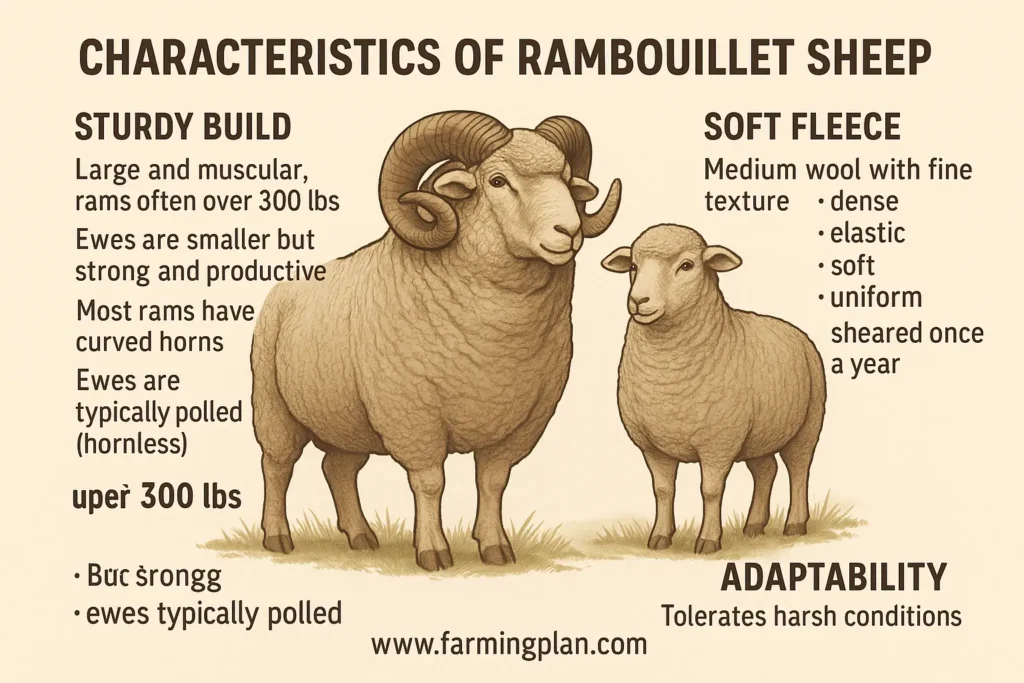
Their wool is one of the breed’s best features. Rambouillets produce medium wool with a fine texture that rivals Merino quality. The density of wool allows for greater fleece yield per animal, and some sheep grow wool so long they only need to be sheared once a year. Their fleece is known for being elastic, soft, and uniform—qualities that are perfect for both clothing and carpet wools.
Another trait that sets Rambouillets apart is their adaptability. Originally bred for the western ranges, these sheep can handle harsh winters, hot summers, and dry grazing lands. Their strong hooves, thick wool, and solid immune system make them ideal for large-scale operations and small farms alike.
Over generations, the breed has kept the good traits of Rambouillet Merinos—fine wool and resilience—while reducing some drawbacks like coarse wools or low body mass. Many breeders consider this animal an all-purpose sheep that performs well in both wool and meat production.
Temperament & Suitability of Rambouillet Sheep
Rambouillet sheep are known for their calm and gentle nature, making them a great choice for both new and experienced shepherds. These sheep are alert but not nervous, which makes them easier to manage in open fields or during shearing. They’re also highly trainable and adapt well to herding routines.
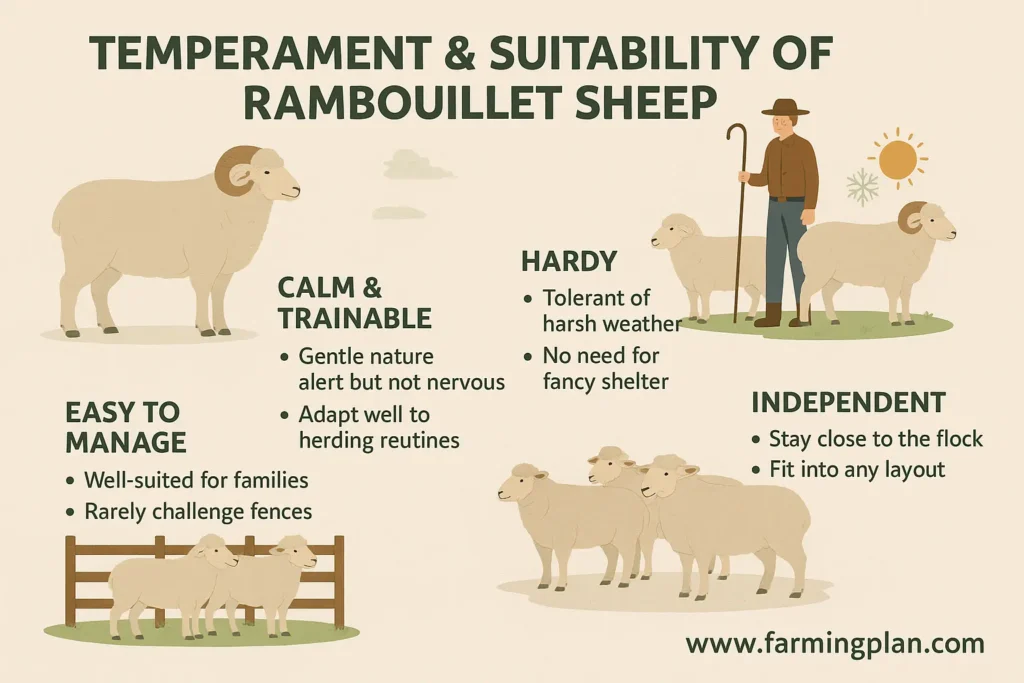
Because they were developed for the western ranges, Rambouillets are naturally hardy. They stay strong in harsh weather, from icy winters to dry, hot summers. This tough personality means they don’t require fancy shelter or constant supervision, which is a huge plus for busy farmers or hobbyists.
Families raising sheep as a project or small farm animals will appreciate how easy Rambouillets are to handle. They don’t challenge fences often and tend to stay close to the flock, reducing the risk of injury or loss.
If you’re looking for a sheep that offers both production and personality, Rambouillets check all the boxes. They’re easy-going, independent, and fit into nearly any flock size or layout.
Food & Diet of Rambouillet Sheep
Feeding Rambouillet sheep the right diet keeps them healthy, productive, and full of energy. These sheep thrive on good pasture but also benefit from a balanced diet of hay, grains, and minerals, especially during breeding and lambing seasons.
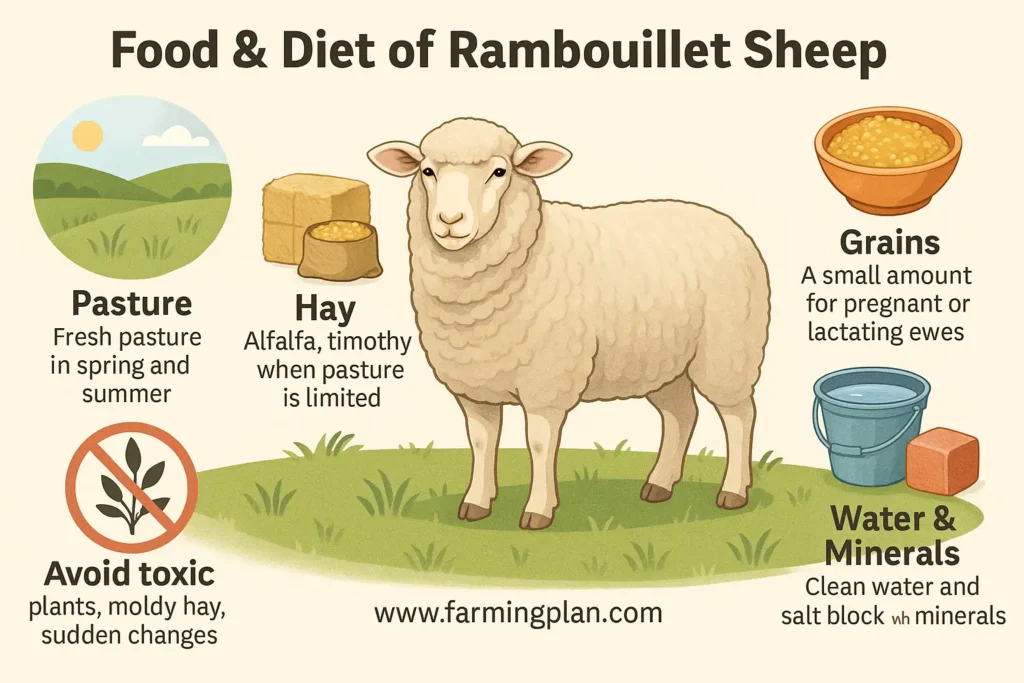
During spring and summer, fresh pasture gives them most of what they need. When grass is limited—like in winter or dry months—feed them high-quality hay such as alfalfa or timothy. For pregnant or lactating ewes, a small amount of grain mix can help boost nutrition.
Always provide clean water and a salt block with added minerals. These support wool growth, bone strength, and overall health. Rambouillet wool grows fast, so proper nutrition directly affects the performance of wool and fleece quality.
Avoid feeding moldy hay or sudden diet changes. Some plants like nightshade or milkweed are toxic to sheep, so double-check what’s growing in their grazing area.
By keeping their diet simple and consistent, you’ll support healthy lambs, strong immune systems, and top-quality wool all year long.
Read More: Beltex Sheep: The Powerhouse Breed Every Farmer Loves
Usage and Economic Purpose of Rambouillet Sheep
Rambouillet sheep are one of the most versatile breeds in the world. Farmers raise them primarily for their high-quality wool, but they’re also valued for meat production and breeding programs. Their adaptability and strong genetics make them a smart choice for both small farms and large ranches.
Wool from Rambouillet sheep is soft, dense, and elastic—perfect for both fine clothing and carpet wools. Their fleece is highly sought after by textile companies and wool processors because of its length, strength, and fine texture. Rambouillets are often used in studies by wool authorities and selected for wool samples during fleece competitions or research trials.
Thanks to their well-muscled bodies, Rambouillets also provide a solid source of lean meat. Though not raised strictly for meat, they produce quality lamb that appeals to many markets.
This breed has played a key role in the development of textiles, especially in the U.S. It has even contributed to mechanical developments related to shearing and finishes imparting softness or durability to wool. Their wool helped inspire research into Inca cotton wool fabrics and even ancient uses of fiber back to earliest times.
Rambouillet genetics are also used to strengthen other flocks. Many modern medium wool and coarser wool breeds owe part of their lineage to the Rambouillet. This makes them a top choice for anyone serious about long-term flock improvement.
Read More: Texel Sheep: The Secret to High-Yield Lambs and Quality
Special Features of Rambouillet Sheep
Rambouillet sheep stand out from other breeds because of their unique blend of strength, wool quality, and history. One of their most impressive features is the ability to grow a heavy fleece that can weigh up to 18 pounds per year. This wool is dense, fine, and elastic—making it perfect for both soft clothing and tough coarse wools like carpets and industrial textiles.
Unlike other breeds, Rambouillets adapt quickly to harsh environments. Whether it’s the dry western ranges or cold northern farms, they stay healthy and productive. Their hooves are tough, their immune systems are strong, and they handle weather extremes with ease.
This breed has played a key role in the development of textiles, with its wool often used to test finishes imparting softness and durability. Their influence can even be found in innovations going back to the 14th and 15th centuries, when wool was a major part of trade and fashion.
Rambouillets also pass on their traits to other breeds. They’ve helped improve body size and fleece quality in countless flocks across the globe. Their long, fine fibers are often compared to Merino wool, but with added strength and length, thanks to selective breeding.
Many breeders consider the Rambouillet a living treasure—part of a long line that began with royal flocks at the Bergerie royale, and now part of a worldwide legacy.
Read More: Columbia Sheep: First Breed in the United States
Health Issues & Prevention in Rambouillet Sheep
Like all livestock, Rambouillet sheep can face health problems—but with good care, most issues are easy to manage or prevent. These sheep are generally hardy, but they still need routine checkups, clean environments, and proper nutrition to stay in top shape.
One concern specific to wool-producing breeds is wool blindness, where overgrown fleece blocks the sheep’s vision. Regular shearing helps prevent this and keeps the sheep cool in warmer seasons. Keep the wool trimmed around the face, especially in mature animals.
Internal parasites like worms can also affect Rambouillets, especially in wet pastures. Deworm your flock regularly and rotate grazing areas to reduce buildup. Watch for signs like weight loss, diarrhea, or dull wool.
Foot rot is another common issue, especially in damp conditions. Keep hooves trimmed and pens dry. A clean, dry shelter helps prevent many bacterial infections and keeps fleece clean, which improves the performance of wool during processing.
Rambouillet lambs are usually healthy, but vaccinating them early protects against diseases like clostridial infections. Always provide clean water, fresh feed, and mineral blocks to support immune health.
“Mastering Rambouillet Sheep Care: From Fine Wool to Hearty Meat, These Hardy Sheep Are a Farmer’s Best Friend!”
Step-by-Step Farming Guide for Rambouillet Sheep
Raising Rambouillet sheep can be a rewarding experience, whether you’re a seasoned farmer or a beginner. Here’s a comprehensive, step-by-step guide to help you set up your farm, care for your sheep, and ensure they thrive year-round.
1. Setting Up Your Farm
- Fencing & Shelter: Start by securing proper fencing to keep your sheep safe. Rambouillets are good at staying within boundaries but always double-check gates. Use 4 to 5-foot high woven wire fences for durability.
- Shelter: A basic three-sided barn or lean-to is enough to protect your sheep from extreme weather. Make sure it’s well-ventilated but draft-free.
2. Selecting Healthy Stock
- When buying Rambouillet sheep, choose healthy animals with good wool quality and strong bodies. Check for clean hooves, no signs of disease, and look for any unusual wool patterns, which could indicate health issues.
- Consider contacting breeders like Culham & Livley Rambouillets or McGivney Rambouillets to ensure you’re getting quality stock.
3. Feeding Schedule
- Pasture: In warm months, provide ample fresh grass. In winter, supplement with hay like alfalfa or clover.
- Minerals & Salt: Place mineral blocks in the pasture to help with wool growth and overall health.
- Water: Always provide fresh, clean water. Make sure there are no standing puddles, as stagnant water can attract pests or bacteria.
4. Breeding and Lambing
- Breeding: Aim to breed your ewes in the fall. Lambing will typically occur in spring when the weather is milder. Ensure that breeding stock comes from healthy, proven lines.
- Lambing: Provide a clean, dry area for ewes to give birth. Watch for complications and assist if necessary. Newborn lambs need colostrum quickly for proper immunity.
5. Shearing and Wool Storage
- Shearing: Sheep should be sheared once a year. This helps prevent wool blindness and keeps them comfortable. The best time to shear is in late spring or early summer when the weather is warmer.
- Wool Storage: After shearing, keep wool clean and dry. Store it in breathable bags until it’s ready for sale or processing.
6. Daily Maintenance and Health Checks
- Health Monitoring: Look for signs of wool blindness, infections, or weight loss. Regularly check hooves and trim as necessary.
- Deworming & Vaccinations: Schedule deworming and vaccinations based on your local climate and veterinarian advice. Make sure to rotate grazing areas to avoid parasite buildup.
By following this guide, you’ll have a productive flock that thrives on minimal intervention but performs exceptionally in wool and meat production.
FAQ
What is the origin of Rambouillet sheep?
Rambouillet sheep originated in France in 1786 when King Louis XVI imported Spanish Merino sheep to improve local stock. They were developed at the Bergerie royale, leading to the Rambouillet breed known for its fine wool and adaptability.
What are the key characteristics of Rambouillet sheep?
Rambouillet sheep are large, with rams weighing 250–300 lbs and ewes 150–200 lbs. They produce fine wool with a fiber diameter of 18.5–24.5 microns and a staple length of 2–4 inches. Their wool yield ranges from 35% to 55%.
Are Rambouillet sheep suitable for meat production?
Yes, Rambouillet sheep are a dual-purpose breed, raised for both wool and meat. Their lambs grow rapidly and reach market weight at 6–9 months, making them valuable for meat production.
How do Rambouillet sheep handle different climates?
Rambouillet sheep are hardy and adaptable, thriving in various climates. They are well-suited for both cold and hot environments, making them ideal for diverse farming conditions.
What are common health issues in Rambouillet sheep?
Common health concerns include wool blindness due to overgrown fleece, internal parasites, and foot rot. Regular shearing, deworming, and hoof care are essential for maintaining their health.
Conclusion
Rambouillet sheep are a dual-purpose breed renowned for their fine wool and adaptability. Originating in France through the crossbreeding of Spanish Merino sheep, they have become a staple in wool production worldwide. Their large size, rapid lamb growth, and resilience to various climates make them valuable for both meat and wool. While they require regular care, including shearing and parasite management, their calm temperament and productivity make them a favorable choice for farmers and breeders.

